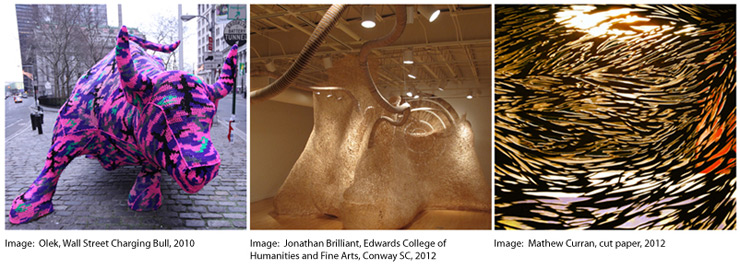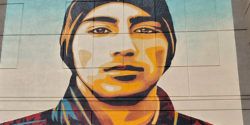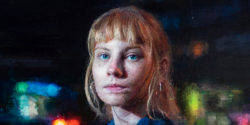Make Ends Meet
Henry Moore is credited with saying, “There’s no retirement for an artist; it’s your way of living, so there’s no end to it.” Moore’s words outline art making not simply as profession, but as compulsion. Make Ends Meet is an exhibition that celebrates the repetition of a daily grind, as it features the incredibly inventive, yet remarkably labor-intensive works of Jonathan Brilliant, Mathew Curran, and Olek. Only compulsion could inspire these artists to employ the countless connections, cuts, and knots necessary to create their works.
Jonathan Brilliant’s oeuvre appropriates the throwaway accessories of the coffee shop – the wooden stirrers, the cardboard sleeves, and the plastic lids – to create tension-woven installations and an assortment of prints inspired by those installations. His large-scale forms, utilizing thousands of these often overlooked items, thread, engulf, and cocoon space. His concentration on such materials speaks not only to his personal attachment to the coffee shop; as he writes, “In my vision [of the installations as the “Goldsworthy of the coffee shop project”], the coffee shop is my natural environment and source of inspiration for materials.” It also demonstrates Ray Oldenburg’s urban sociology theory that locations like coffee shops are the “third place” in an active community, following the spheres of work and home. Brilliant’s installations give abstracted form to this third place. Because coffee shops are communal locations for sustenance and socialization, their contents are immediately recognizable to a wide audience. However, in his methodical, excruciatingly exacting constructions, Brilliant combines these items in such a fashion that he negates their seeming familiarity and insignificance. Their resulting beauty instead appears sublimely foreign.
Mathew Curran has spent years exploring the potential in stencil art. An art form that offers technical possibilities of traditional printmaking and also represents a form of urban art, each stencil requires hours of cutting with an unforgiving X-acto blade. His current stencil work negotiates the intersections of natural and urban life. For him, nature is “a background character in every one of our interactions,” regardless of one’s location in the world. To communicate this duality, he has started turning to representations of white-tailed deer and ravens. While the choice of animals as his subject matter may seem to suggest an essential, potentially simpler, state of being, he uses jagged strokes to remind the viewer that the frenzy of urban life is echoed in the chaos of nature. Ravens have a long-standing connotation of death, and he utilizes studies of hunted, dead deer in his compositions. For him, these animals are metaphorical stand-ins for the complexities of survival across habitats and species. In this exhibition, he evolved from his traditional black-and-white palette, and he introduces the color of North Carolina red clay in his works to make specific reference to one of the current background characters of his home and environment.
Olek has spent the past decade in America “aggressively re-weaving the world as she sees fit.” She describes her own compulsion best when she writes, “A loop after loop. Hour after hour my madness becomes crochet.” Whether she uses wool or balloons, few things are safe from her intervention, be it covering the Wall Street Bull or entrapping a shopping cart in crochet. Olek is an artist for whom the entire world is her inspiration and installation. Past pieces include reclaiming entire rooms with crochet, filling a gallery with balloon sculptures, and creating full body suits before sending their wearers into the streets. Drawing from anything between intangible text messages and found everyday objects, she absorbs all into her process and allows them to reemerge covered in her multi-looped, hyper-colored, crocheted visions.
 BROOKLYN STREET ART LOVES YOU MORE EVERY DAY
BROOKLYN STREET ART LOVES YOU MORE EVERY DAY










